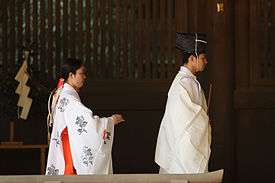Jōe

Jōe (浄衣) (sometimes translated from Japanese as "pure cloth") is a garment worn in Japan by people attending religious ceremonies and activities, including Buddhist and Shinto related occasions. The jōe is essentially a white kariginu, traditional hunting robes worn by nobles during the Heian period.
Not only Shinto and Buddhist priests can be found wearing Jōe at rituals, but laymen as well, for example when participating in pilgrimage such as the Shikoku Pilgrimage. The garment is usually white or yellow and is made of linen or silk depending on its kind and use.
The Shinto priest who wears the jōe is attired in a peaked cap called tate-eboshi, an outer tunic called the jōe proper, an outer robe called jōe no sodegukuri no o, an undergarment called hitoe, ballooning trousers called sashinuki or nubakama, and a girdle called jōe no ate-obi. He can carry a ceremonial wand called haraegushi or another called shaku, as in the photo.
External links
- Basic terms of Shinto (with illustration)
- Courtier in Shinto ceremonial robe (with illustration)
- "Jo-e (浄衣)". Yahoo! Encyclopedia (Shogakukan 日本大百科全書) (in Japanese). Shogakukan. Retrieved 2009-04-10.
